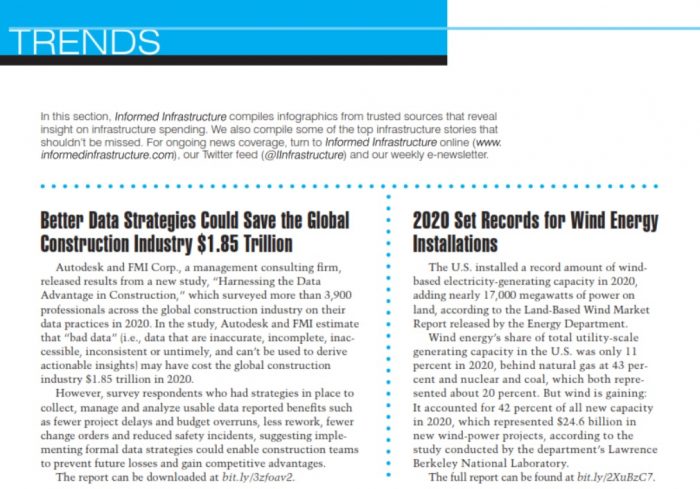October 2021 Trends

Autodesk and FMI Corp., a management consulting firm, released results from a new study, “Harnessing the Data Advantage in Construction,” which surveyed more than 3,900 professionals across the global construction industry on their data practices in 2020. In the study, Autodesk and FMI estimate that “bad data” (i.e., data that are inaccurate, incomplete, inaccessible, inconsistent or untimely, and can’t be used to derive actionable insights) may have cost the global construction industry $1.85 trillion in 2020.
However, survey respondents who had strategies in place to collect, manage and analyze usable data reported benefits such as fewer project delays and budget overruns, less rework, fewer change orders and reduced safety incidents, suggesting implementing formal data strategies could enable construction teams to prevent future losses and gain competitive advantages.
The report can be downloaded at bit.ly/3zfoav2.
2020 Set Records for Wind Energy Installations
The U.S. installed a record amount of wind-based electricity-generating capacity in 2020, adding nearly 17,000 megawatts of power on land, according to the Land-Based Wind Market Report released by the Energy Department.
Wind energy’s share of total utility-scale generating capacity in the U.S. was only 11 percent in 2020, behind natural gas at 43 percent and nuclear and coal, which both represented about 20 percent. But wind is gaining: It accounted for 42 percent of all new capacity in 2020, which represented $24.6 billion in new wind-power projects, according to the study conducted by the department’s Lawrence Berkeley National Laboratory.
The full report can be found at bit.ly/2XuBzC7.
Report Blames Poor Welds For Mexico City Subway Collapse
According to a report from Norwegian certification firm DNV, poorly welded, badly located and completely missing studs that joined steel support beams to a concrete layer supporting the track bed were to blame for the May 3, 2021, collapse of an elevated segment of Mexico City’s metro that killed 26 people.
Hired by the Mexico City government, DNV concluded that the sloppy installation of the studs created a situation where the elevated structure was working as “two independent parallel beams, a concrete beam and a steel beam, that experienced loading conditions for which they were not designed,” the report said. This situation distorted the framework, leading to “fatigue cracks” that reduced the structure’s ability to bear weight.
Other possible factors included deficiencies in the beams themselves and the design of the framework, the report said.
The metro was built by a consortium of Mexico’s ICA; Grupo Carso, a company controlled by the family of Mexican tycoon Carlos Slim; and French trainmaker Alstom SA.
FRA Making $362 Million in CRISI Grants Available
The Federal Railroad Administration (FRA) issued a notice of funding opportunity (found at bit.ly/2XqqkLg) regarding the availability of nearly $362 million via its Consolidated Rail Infrastructure and Safety Improvements (CRISI) grant program.
The agency said its CRISI program funds projects that reduce congestion, improve short-line and regional railroad infrastructure, relocate rail lines, enhance multi-modal connections and facilitate service integration between rail and other facilities such as at ports or intermodal facilities.
The following are funding “set asides” within this round of CRISI grants:
• Rural set-aside: No less than $93.7 million or 25 percent for rural projects.
• Intercity passenger rail development: No less than $75 million for eligible projects supporting the development of new intercity passenger rail routes, including alignments for existing routes.
• Capital improvements for trespass prevention: No less than $25 million for capital projects and engineering solutions targeting rail trespassing.

The Solar Futures Study modeled the deployment of solar necessary for a decarbonized grid. Preliminary modeling shows that decarbonizing the entire energy system could result in as much as 3,000 GW of solar due to increased electrification.
On Sept. 8, 2021, the U.S. Department of Energy Solar Energy Technologies Office (SETO) and the National Renewable Energy Laboratory (NREL) released the “Solar Futures Study,” which explores solar energy’s role in transitioning to a carbon-free electric grid. The study finds that with aggressive cost reductions, supportive policies, and large-scale electrification, solar could account for as much as 40 percent of the nation’s electricity supply by 2035 and 45 percent by 2050.
Read the full study at bit.ly/3nIV9FX.
TOP Stories
The following are the top stories from the last few months (in terms of traffic) on the Informed Infrastructure website. This also reflects key coverage areas that are regularly refreshed online and via our weekly e-newsletter. Simply search key words on Informed Infrastructure online to find the full story.
Buildings
• Hybrid Sandwich Wall Element: Sustainable and Efficient Construction
• EW Howell Construction Group Completes The Residences at Plainview for Capitol Seniors Housing
• Hycrete Chosen for “Little Island” – Pier 55 Renovation Project
• Video: Official One Vanderbilt Construction Timelapse Movie
Transportation
• Video: AASHTO 2021 Benefits of Transportation Report
• Worldwide Transport Activity to Double, Emissions to Rise Further
• Podcast: Mobility Digital Twins
• Acrow Engineers a Unique Solution for Safe, Permanent Recreational Bridge in New Brunswick, Canada
Water
• Water Is Life: Protecting Water Resources and Infrastructure With Purpose-Built Cloud Technology
• DuPont Selected to Provide Membrane Technology to Sorek B, Israel’s Largest Desalination Plant
• New ASCE Geotechnical Publication Examines Two Recent Dam Failures
• Reclamation Launches Website with Real-Time Information, Interactive Resources On Drought
• Automating Process Cooling to Eliminate “Strainer Danger”
Tools and Technology
• Virtual Surveyor Introduces Enhanced Stockpile Reporting in Drone Surveying Software
• Artificial Intelligence: On the Verge to Disrupt and Transform the Building Life Cycle
• FARO Expands Digital Twin Product Suite, Acquires HoloBuilder Inc.


